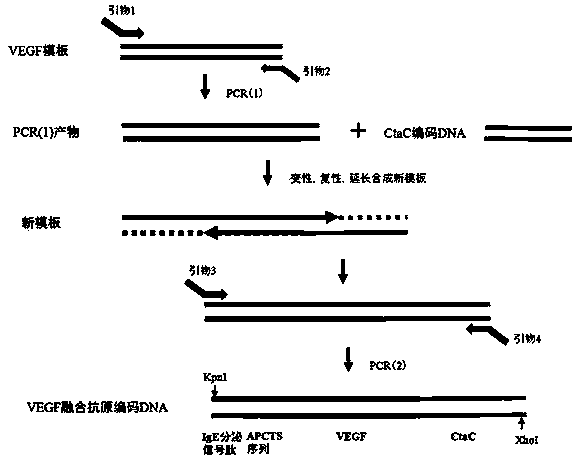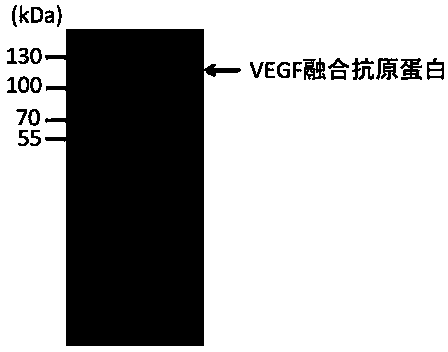Method for generating novel induction antibody
An antibody and antigen technology, applied in the fields of immunology and genetic engineering, can solve the problem of low protein antigenicity
- Summary
- Abstract
- Description
- Claims
- Application Information
AI Technical Summary
Problems solved by technology
Method used
Image
Examples
example 1
[0026] Example 1: Construction of eukaryotic expression vector for fusion antigen protein of APCTS-human VEGF-Mycobacterium tuberculosis cytochrome C oxidase subunit II CtaC
[0027] First, the DNA encoding the fusion protein was synthesized by overlapping PCR (overlapping PCR). The specific method is as follows: figure 2 shown. Unless otherwise specified, all molecular biology experiments in the present invention are performed according to the literature: Green, M.R: Molecular cloning, A Laboratory Manual (4th), Cold Spring Harbor Press, 2012. First synthesize four oligonucleotide primer fragments: (1) 5' ATGTTTTCTCGCATGACCTCGCTCATTATGGGTAACAACTTTCTGCTGTCTTGG 3'; (2) 5' TGGCTCGCGAGGTGTCACCCGCCTCGGCTTGTCACATCT
[0028] 3'; (3) 5' ATCGCTCGAGCTAACCTACGGGCATCGG 3'; (4) 5' ACTGGGTACCATGGACTGGACCTGGATA CTGTTCCTGGTG GCC GCCGCCACACGGGTGCACAGCACCTCGCTCATTATGGGT 3'. Primer (1) contains the coding sequence of APCTS and the coding sequence of 6 amino acid residues at N-te...
example 2
[0059] Example 2: Expression of APCTS-human VEGV-CtaC fusion antigen protein in eukaryotic cells and preparation of VEGF-specific antibody in rabbits by DNA immunization
[0060] 293T cells were cultured in culture dishes in DMEM medium containing 10% fetal calf serum (FCS). When the cell density reaches 70% of the confluency, use the FuGENE® HD transfection reagent kit produced by Roche Company to express the fusion antigen protein eukaryotic expression vector pcDNA3.1-human VEGF fusion constructed in Example 1 according to the instructions Antigen expression plasmids were transfected into 293T cells. Place the transfected 293T cells at 37°C, 5% CO 2 Continue culturing in the incubator for 48 hours. Take out the culture dish, remove the culture supernatant, and wash the culture dish once with PBS. Cells were then lysed with 1×Lamelli loading buffer, ultrasonically disrupted, and the sample was treated at 95°C for 5 minutes; then the precipitate was removed by centrifugat...
example 3
[0063] Example 3 DNA immunization with VEGF fusion antigen protein eukaryotic expression vector to prepare VEGF-specific mouse monoclonal antibody
[0064] The eukaryotic expression vector plasmid expressing VEGF fusion antigen protein was prepared in normal saline at a concentration of 1 mg / ml, and 50 μL of the plasmid was injected intradermally at multiple points in the hind leg muscles and back of Balb / c mice. At the same time, on the 14th day and 28th day after the injection, the plasmid preparation of the same dose was repeatedly injected in the same way. The tail vein blood samples of mice were taken, and the titer of VEGF-specific antibody in serum of immunized mice was determined by ELISA method. When the antibody titer was greater than 1:10000, 3 days before the spleen of the mouse was taken for cell fusion, 293T cells (5×10 6 Cells suspended in 100 μl saline) for booster immunization in the abdominal cavity of mice. Then, according to the conventional method (Har...
PUM
 Login to View More
Login to View More Abstract
Description
Claims
Application Information
 Login to View More
Login to View More - R&D
- Intellectual Property
- Life Sciences
- Materials
- Tech Scout
- Unparalleled Data Quality
- Higher Quality Content
- 60% Fewer Hallucinations
Browse by: Latest US Patents, China's latest patents, Technical Efficacy Thesaurus, Application Domain, Technology Topic, Popular Technical Reports.
© 2025 PatSnap. All rights reserved.Legal|Privacy policy|Modern Slavery Act Transparency Statement|Sitemap|About US| Contact US: help@patsnap.com



